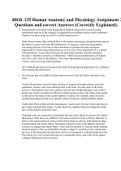Exam (elaborations)
BIOL 235 Human Anatomy and Physiology Assignment 3 Questions and correct Answers (Correctly Explained).
- Course
- BIOL 235 (BIOL235)
- Institution
- Athabasca University (AU )
BIOL 235 Human Anatomy and Physiology Assignment 3 Questions and correct Answers (Correctly Explained). 1. Some patients who suffer from hypertension (high blood pressure) are prescribed medications that are in the category of angiotensin-converting enzyme (ACE) inhibitors. Explain why these dru...
[Show more]



